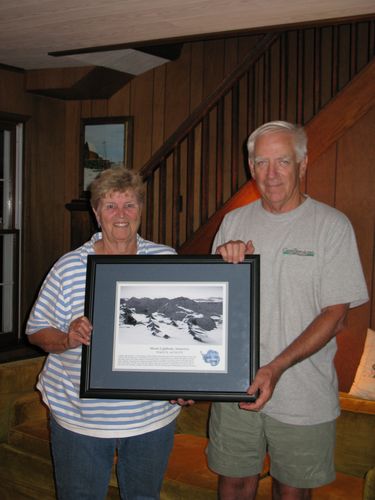I had the privilege of spending last evening with Jack Lightbody and his wife Sonny. They are such a warm, amiable, down to earth couple that you would never guess what Jack did for a living up until his retirement this past January. Here's a brief biography.
John W. (Jack) Lightbody was a National Science Foundation Program Officer in the Office of Polar Programs for the IceCube Neutrino Project from 2001-09. While overseeing this project, he also served the NSF as Deputy Director for the Division of Physics (until 2007) and then as Deputy Assistant Director of NSF for the Directorate for Mathematics and Physical Sciences until his retirement in January 2009.
I was able to connect with Jack and his wife through a colleague, Susan Ryan. Susan's father and Sonny are cousins, so when Susan found out I was going to Antarctica, she recommended that I get in touch with Jack and then helped facilitate that via e-mail.
Listening to Jack talk about (and tell a few stories) about Antarctica, McMurdo, the South Pole and the IceCube Neutrino Project was fascinating to say the least. I sure am glad that Sonny insisted that he bring his photo album, as I never tire of seeing pictures of this "other world" continent.
I keep telling people that safety is the number one concern down there because if you get sick, injured or make a poor decision you are putting someone else's life in danger. Jack reinforced that message. He said that people sometimes tire of doing things the same way over and over again and perhaps want to take a shortcut. Should you take the shortcut? NEVER! There are procedures and rules for a reason, and it's not to make everyone's life more difficult. It's to keep everyone safe-period!
After all of my questions had been asked and answered, Jack's eyes really started to dance and twinkle as he said, "Now let me tell you about the IceCube." Fortunately, one of our 2009 PolarTREC teachers, Casey O'Hara, had created a short animated video using SAM Animation that explained the basics of the project, so I had a better grasp of the what it was, what neutrinos and muons were and what scientists are hoping to find by using this "in ice" telescope. Check out his short video. http://www.polartrec.com/resources/video/10312
Jack's explanation and detail about the project, why it was built in Antarctica and not Greenland, the logistics involved in the project and what scientists hope to discover was positively riveting. (Those of you who know me shouldn't be shocked at that!) Between Jack's thorough explanation and Casey's introductory video, I believe I can give a good summary of the project and explain it in understandable terms like both men did.
**Trivia time! Why was the IceCube built in Antarctica and not Greenland? **
For those of you wanting more information about the project, you can visit Casey's site on this website, or you can check out the following link. http://icecube.wisc.edu/
After a most enjoyable and informative evening, sadly it was time to head back home. But, before I left, I asked if I could take a picture of Jack and Sonny with Jack's latest "award" between them. (Jack is such a humble man that I learned about this from his very proud wife-and rightly so!) Jack recently had an Antarctic mountain named after him in honor of his service and many contributions in the area of Polar Sciences.
 Jack and Sonny holding a beautiful picture of the mountain recently named after Jack
Jack and Sonny holding a beautiful picture of the mountain recently named after Jack
If you'd like to see a satellite image of Mt. Lightbody, here are the directions for doing so. I can't give you the link alone because the system only adds temporary session identification numbers to the URL. If you bookmark or copy and paste the entire URL with numbers, it will not work in the future, hence the directions. Consider it practice in following step-by-step directions in the wonderful world of technology!
1) The following link should take you to the Query Form. http://geonames.usgs.gov/pls/gnispublic/f?p=gnispq:1:249056747972242::NO::P1_SHOW_ANTAR,P1_SHOW_ADV,P1_SHOW_FIPS55:Y 2) "Lightbody" should already be in the Feature box. If not, type it in 3) Click on Send Query 4) Next click on Lightbody, Mount in the Feature Name box 5) That will take you to the Antarctic Feature Detail page 6) To the right you will see a box called Antarctica Map. 7) Click on the link in the box and that will take you to a satellite image of the area 8) Lightbody Mount is in the center of the page
And most importantly, Jack and Sonny...thank you for a most memorable evening!

